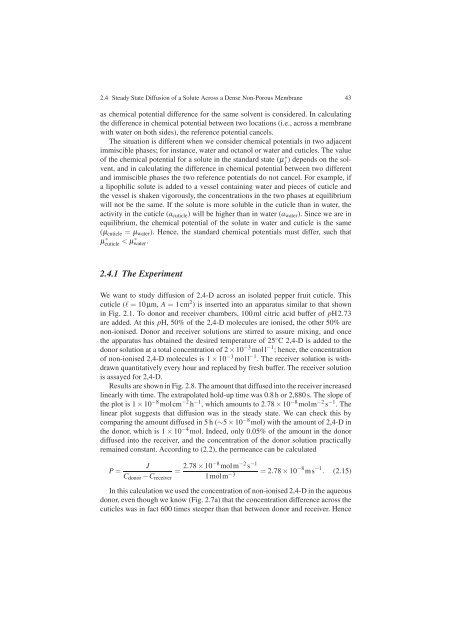Water and Solute Permeability of Plant Cuticles: Measurement and ...
Water and Solute Permeability of Plant Cuticles: Measurement and ...
Water and Solute Permeability of Plant Cuticles: Measurement and ...
You also want an ePaper? Increase the reach of your titles
YUMPU automatically turns print PDFs into web optimized ePapers that Google loves.
2.4 Steady State Diffusion <strong>of</strong> a <strong>Solute</strong> Across a Dense Non-Porous Membrane 43<br />
as chemical potential difference for the same solvent is considered. In calculating<br />
the difference in chemical potential between two locations (i.e., across a membrane<br />
with water on both sides), the reference potential cancels.<br />
The situation is different when we consider chemical potentials in two adjacent<br />
immiscible phases; for instance, water <strong>and</strong> octanol or water <strong>and</strong> cuticles. The value<br />
<strong>of</strong> the chemical potential for a solute in the st<strong>and</strong>ard state (µ ∗ j<br />
) depends on the sol-<br />
vent, <strong>and</strong> in calculating the difference in chemical potential between two different<br />
<strong>and</strong> immiscible phases the two reference potentials do not cancel. For example, if<br />
a lipophilic solute is added to a vessel containing water <strong>and</strong> pieces <strong>of</strong> cuticle <strong>and</strong><br />
the vessel is shaken vigorously, the concentrations in the two phases at equilibrium<br />
will not be the same. If the solute is more soluble in the cuticle than in water, the<br />
activity in the cuticle (acuticle) will be higher than in water (awater). Since we are in<br />
equilibrium, the chemical potential <strong>of</strong> the solute in water <strong>and</strong> cuticle is the same<br />
(µcuticle = µwater). Hence, the st<strong>and</strong>ard chemical potentials must differ, such that<br />
µ ∗ cuticle < µ∗ water.<br />
2.4.1 The Experiment<br />
We want to study diffusion <strong>of</strong> 2,4-D across an isolated pepper fruit cuticle. This<br />
cuticle (ℓ = 10µm, A = 1cm 2 ) is inserted into an apparatus similar to that shown<br />
in Fig. 2.1. To donor <strong>and</strong> receiver chambers, 100 ml citric acid buffer <strong>of</strong> pH2.73<br />
are added. At this pH, 50% <strong>of</strong> the 2,4-D molecules are ionised, the other 50% are<br />
non-ionised. Donor <strong>and</strong> receiver solutions are stirred to assure mixing, <strong>and</strong> once<br />
the apparatus has obtained the desired temperature <strong>of</strong> 25 ◦ C 2,4-D is added to the<br />
donor solution at a total concentration <strong>of</strong> 2 × 10 −3 moll −1 ; hence, the concentration<br />
<strong>of</strong> non-ionised 2,4-D molecules is 1 × 10 −3 moll −1 . The receiver solution is withdrawn<br />
quantitatively every hour <strong>and</strong> replaced by fresh buffer. The receiver solution<br />
is assayed for 2,4-D.<br />
Results are shown in Fig. 2.8. The amount that diffused into the receiver increased<br />
linearly with time. The extrapolated hold-up time was 0.8 h or 2,880 s. The slope <strong>of</strong><br />
the plot is 1 × 10 −8 molcm −2 h −1 , which amounts to 2.78 × 10 −8 molm −2 s −1 . The<br />
linear plot suggests that diffusion was in the steady state. We can check this by<br />
comparing the amount diffused in 5 h (∼5 × 10 −8 mol) with the amount <strong>of</strong> 2,4-D in<br />
the donor, which is 1 × 10 −4 mol. Indeed, only 0.05% <strong>of</strong> the amount in the donor<br />
diffused into the receiver, <strong>and</strong> the concentration <strong>of</strong> the donor solution practically<br />
remained constant. According to (2.2), the permeance can be calculated<br />
P =<br />
J<br />
Cdonor −Creceiver<br />
= 2.78 × 10−8 molm −2 s −1<br />
1molm −3 = 2.78 × 10 −8 ms −1 . (2.15)<br />
In this calculation we used the concentration <strong>of</strong> non-ionised 2,4-D in the aqueous<br />
donor, even though we know (Fig. 2.7a) that the concentration difference across the<br />
cuticles was in fact 600 times steeper than that between donor <strong>and</strong> receiver. Hence







